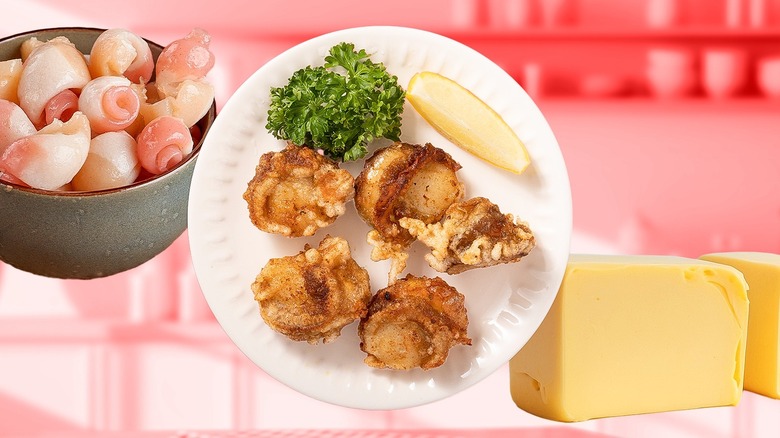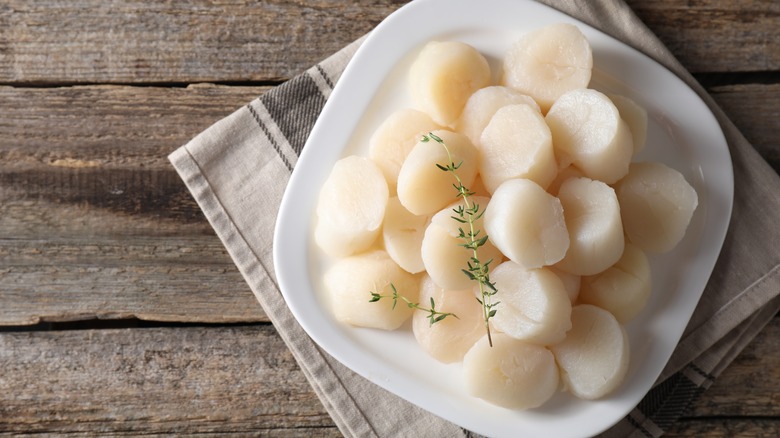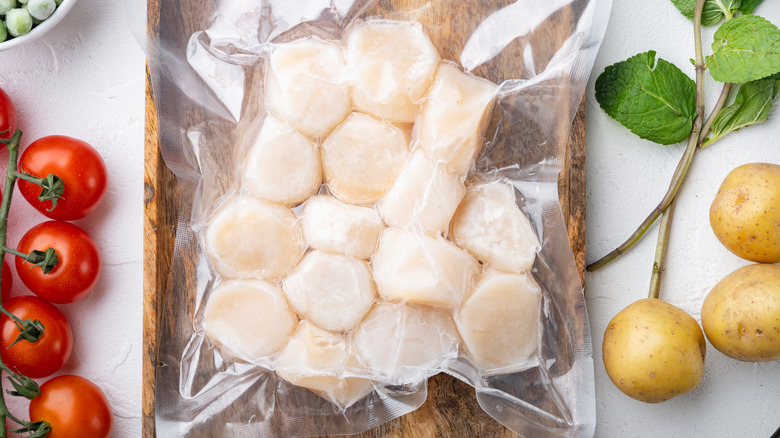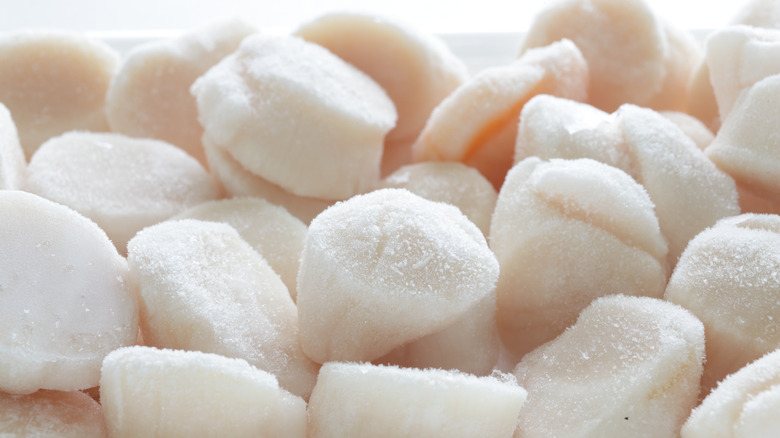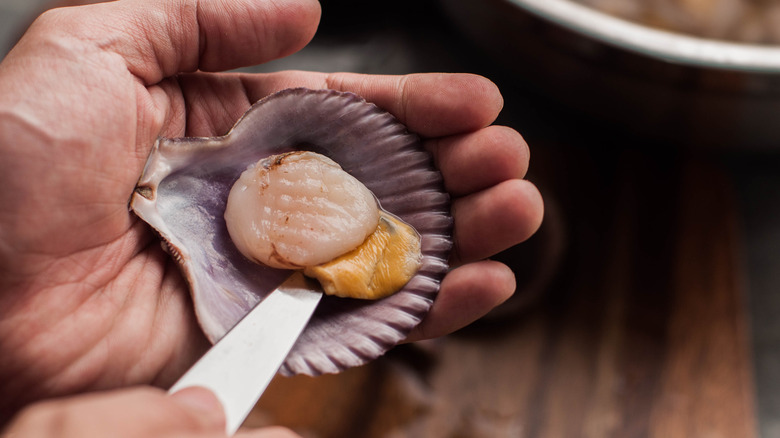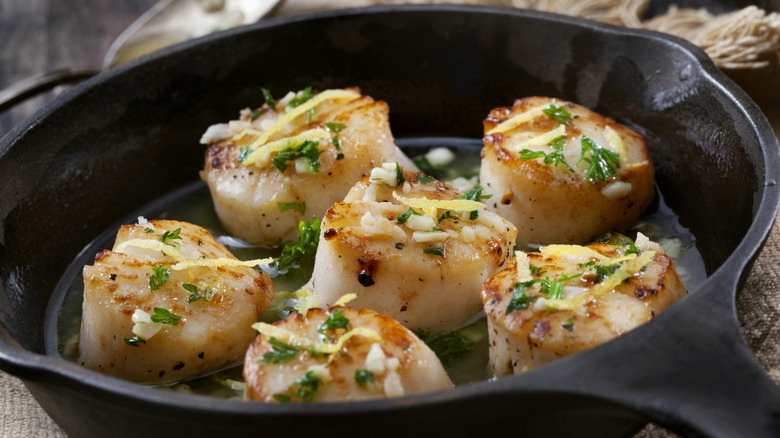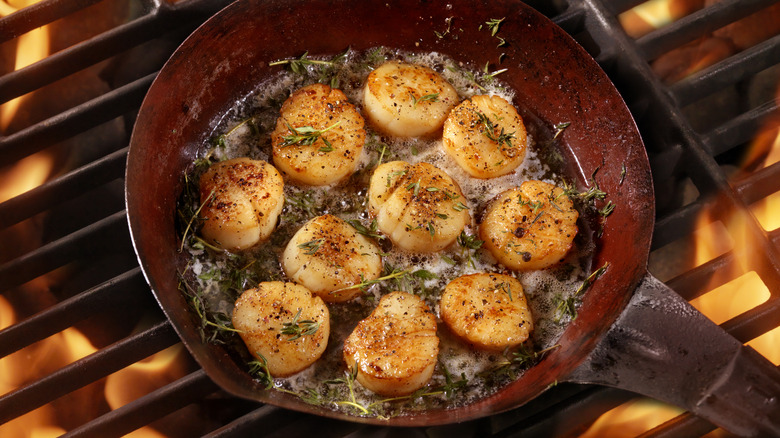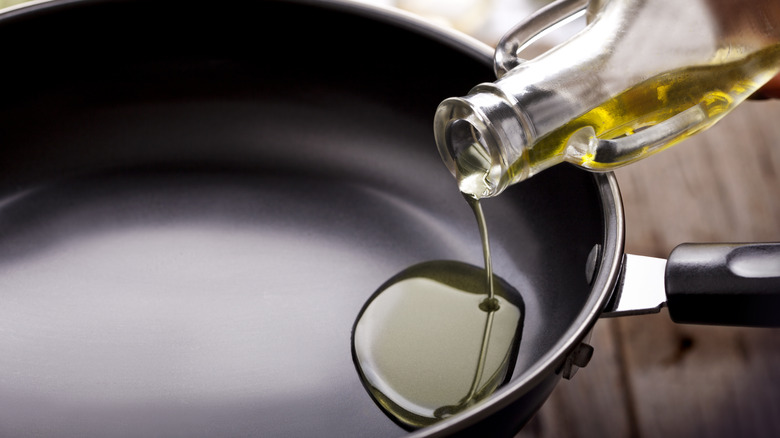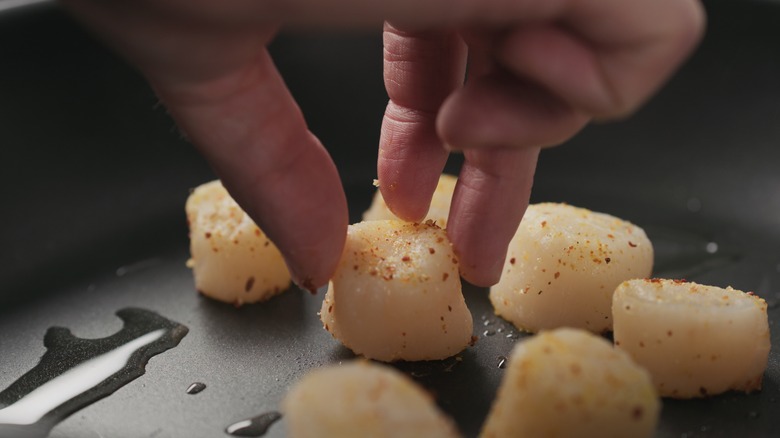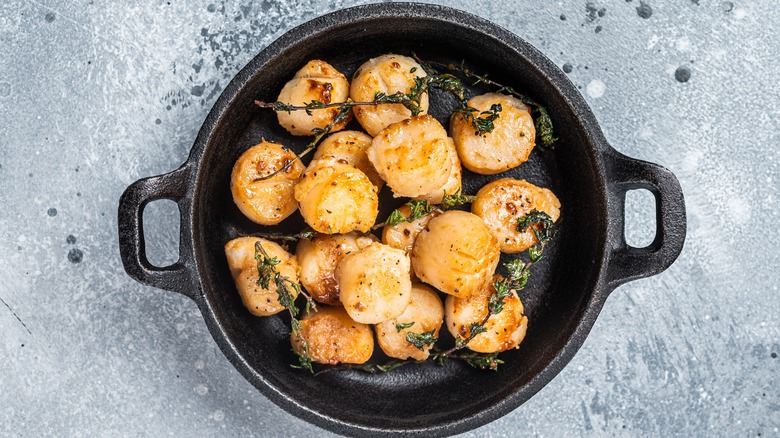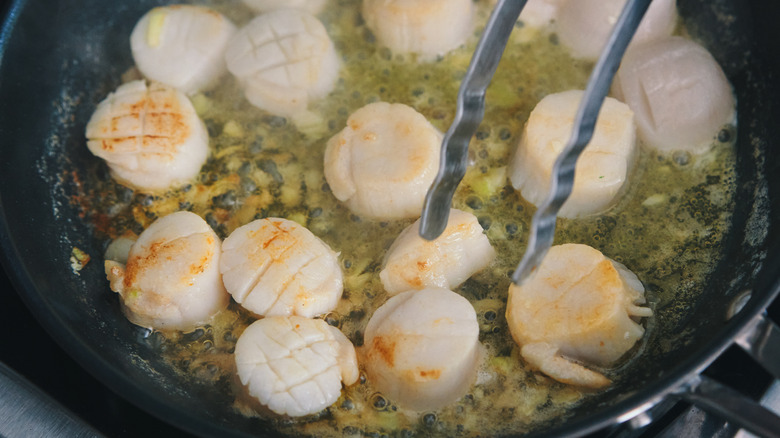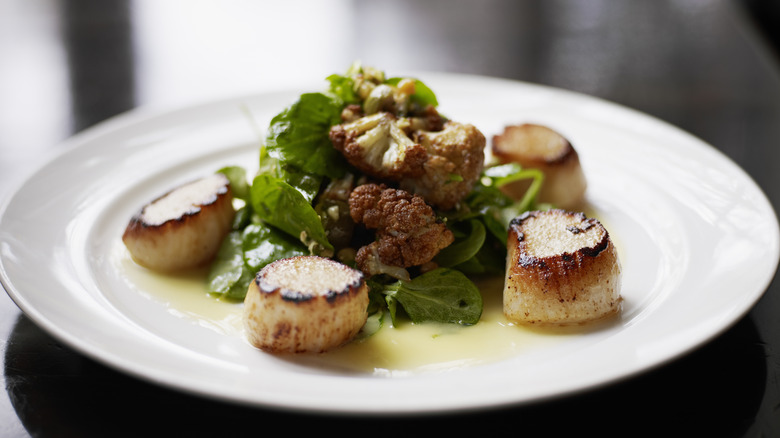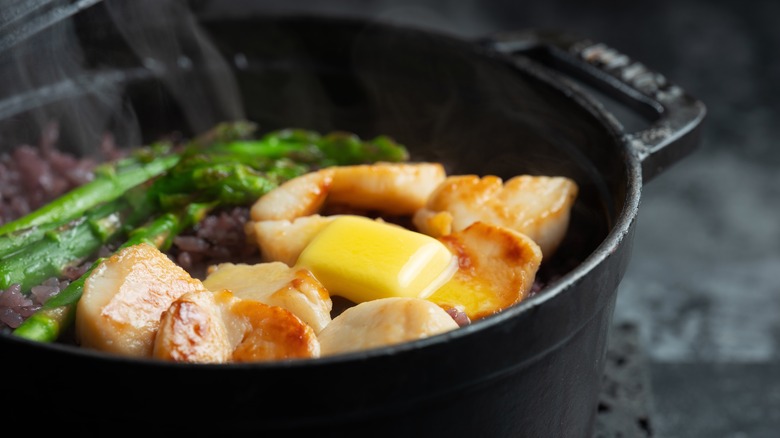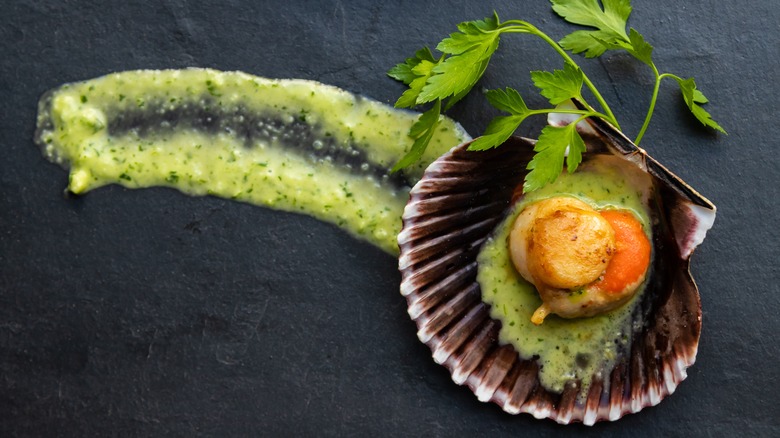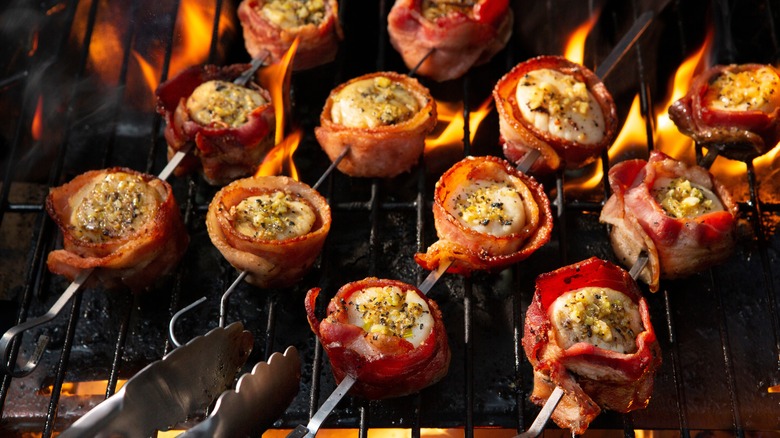Mistakes You're Probably Making When Cooking Scallops
When cooked properly, scallops can be downright delectable. Ideally, you want a nice golden crust on the outside and smooth, silky flesh that offers hints of the ocean and subtle sweetness. Cook them incorrectly though and you could end up with tough, rubbery scallops that are more reminiscent of hockey pucks than the succulent seafood they should be. Scallops can be notoriously tricky to cook, which is why many home cooks don't even try. It doesn't have to be that way though. With a little bit of knowledge, pretty much anyone can cook stellar scallops at home.
To understand how to best cook these delicate bivalves, we went on a fact-finding mission to uncover the biggest missteps people make when cooking scallops. We spoke with several professional chefs who shared their insights on easily preventable mistakes that cause tough, chewy scallops. They offered us expert tips on everything from choosing the best scallops to prepping the shellfish and top cooking techniques. This is their advice on what not to do when cooking scallops and some things you can do instead to create amazing scallop dishes that wouldn't be out of place in a five-star restaurant.
Choosing scallops with the wrong color, smell, or feel
You might think that the main reason your scallops aren't turning out right is because you've cooked them improperly. However, many of the experts we spoke to said that choosing the right scallops is just as important as how you cook them. One of the biggest mistakes people make when buying seafood is not knowing what to look for. With scallops, the main things you want to focus on are the color, smell, and feel of the shellfish.
Michael Morales, culinary director of Sunda New Asian, told Chowhound that the first thing you want to do is choose a reputable seafood source to ensure that you're getting the freshest, highest quality product. "Look for scallops that are odorless — they shouldn't have any strong fishy smell; they should have a clean, neutral scent," Morales said. "Additionally, they should feel smooth and firm to the touch. If they feel sticky or tacky, it's a sign they may not be fresh, and it's best to avoid them." In terms of color, you want scallops that are white, cream-colored, or slightly pink. Avoid any that are yellow, gray, or have dark patches.
Opting for wet or brined scallops
Fresh seafood is always best, but unless you live close to the ocean, it may be hard to find fresh scallops. Packaged scallops are fine, but you should know that how they're packaged can make a huge difference in your final dish. Packaged scallops typically come either wet-packed (brined) or dry-packed. According to many of the experts we spoke to, wet-packed scallops are never worth buying. That's because brined scallops contain some questionable additives.
Gordon Drysdale, culinary director of Scoma's, said, "When selecting scallops at the market, always ask your provider if they are "dry-packed" or "brined." Brined scallops contain a chemical called STPP (sodium tripolyphosphate), which helps them retain water, increasing their weight and price." In addition to falsely inflating the size of the scallops, STPP causes the scallops to release water when cooked, which can prevent you from getting a good sear. Some say the chemical can also make the scallops taste bitter or soapy. Dry-packed scallops are usually flash-frozen with no chemicals, so you get just the natural meat with no excess water or flavors.
Improperly thawing frozen scallops
If you don't have access to fresh scallops, it's perfectly okay to buy frozen scallops. In fact, many dry-packed scallops are flash-frozen within hours of being harvested when they're at their peak freshness. Executive chef Ben Baird of Pelican Seafood Market and Grill told us that frozen scallops may even be the better choice. "Be cautious with 'fresh' scallops, as they are often thawed from frozen stock," he said. "I prefer buying my scallops frozen, as this allows me to control the thawing process."
The thawing process is another area where home cooks often trip up with scallops. You don't want to thaw frozen scallops in the microwave or run them under hot water because this can partially cook the scallops and result in tough, rubbery meat. Baird suggests thawing your scallops in the refrigerator for about 12 hours. He said, "Place them in a colander to allow any excess water to drip off. Once thawed, keep your scallops dry by patting them with paper towels or a clean linen cloth. Store them in the fridge and change the towels frequently to maintain dryness."
Leaving the foot of the scallop on
There's nothing worse than biting into a scallop and getting a mouthful of tough, chewy meat. While several things can cause your scallops to become rubbery, one culprit may be a small part of the scallop that is often overlooked. Ann Ziata, chef at the Institute of Culinary Education advised us, "Remember to remove the side muscle ("foot") of the scallop before cooking. It just gets chewy and rubbery when cooked and is best removed."
The "foot" of the scallop is also called the abductor muscle and it connects the scallop to its shell. If you're buying fresh scallops in the shell, this muscle will most likely still be attached to the scallop. Even packaged scallops may have the "foot" still in place. Fortunately, it's pretty easy to find and remove. The muscle is often darker than the rest of the scallop and feels firmer. Once you find it, you can simply peel it away with your fingertips and discard it. Removing the "foot" will not only eliminate that tough bit, it will also give your scallops a more uniform surface so that they cook more evenly.
Neglecting to use a cast iron pan
Chefs can be pretty particular about the pans they use for certain dishes, and they have good reasons for their preferences. This is especially true for scallops, which cook quickly and can easily stick to the pan. Ideally, you want a pan that will retain heat well and provide a surface that allows the scallops to cook evenly and develop a good crust without getting stuck. Michael Morales told us, "I prefer either a cast iron or non-stick pan for an even sear."
Many chefs swear by cast iron skillets for cooking scallops because the iron holds heat for a long time, so you can maintain that high temperature you need for a good sear. In addition, the skillets can be used on any type of heat source, including the stovetop, grill, or open flames. It should be noted though that one of the myths about cast iron skillets is that they're naturally non-stick. While a well-seasoned cast iron pan can provide some traction, you'll also want to use a bit of oil to prevent the scallops from sticking.
Not getting the pan hot enough
When we asked the experts what the biggest mistake people make when cooking scallops is, nearly all of them told us it was not having a hot enough pan. Executive chef Moira Hill of Ironside Fish & Oyster told us, "The point of the hot temperature is to make sure the sugars in the scallop rise to the surface and make that "crust" sear of golden brown that makes a good-looking and tasting scallop." If your pan isn't hot enough, your scallops may steam instead of sear, and that can result in rubbery meat.
Pre-heating your pan is essential for getting the right temperature. Ann Ziata recommended getting the pan to about 400 degrees Fahrenheit to ensure you get a good sear. One way to check if your pan is hot enough is to throw a few drops of water in the pan. The water should sizzle and dance around the pan. Add your oil and watch for it to start shimmering. It should move around the pan fluidly and stretch in different directions. If the oil starts to smoke, the pan is either too hot or you're using the wrong type of oil.
Using the wrong type of oil or fat
To make sure your scallops don't stick to the pan while searing, you need to use some type of oil or cooking fat. Not just any cooking fat will do though. Because scallops need a screaming hot pan to get a good sear, you need to use an oil or fat that can withstand the heat. "Select an oil with a high smoke point — avocado oil is my favorite, but canola oil works well too," Ben Baird advised. The smoke point is the temperature at which an oil begins to smoke and break down. Olive oil and butter have low smoke points, so they're not ideal for scallops because they'll start to burn before the pan gets hot enough.
Many chefs also recommend using a neutral oil so that you don't overpower the delicate flavors of the scallops. As a bonus, many neutral oils also have a high smoke point. Besides avocado and canola oil, you might want to consider grapeseed oil, soybean oil, or safflower oil. Ghee (clarified butter) is another good option because of its ability to handle high heat, although it will add a slightly nutty flavor to the scallops.
Putting wet scallops in the pan
If you're aiming for a beautiful golden brown crust on your scallops, the last thing you want to do is slap wet scallops into your pan. Many of the chefs we spoke to said that dry scallops are an absolute must for a proper sear. That's because scallops naturally retain water, so if they're not patted dry, that extra water will seep out and prevent the crust from forming. The water will also steam the scallops, which can give your scallops an unappetizing texture.
For a great sear, make sure to pat your scallops dry with paper towels or a kitchen towel before placing them in the pan. Executive Chef Jeff Pfeiffer of Lobster Bar Sea Grille offered another tip for getting a great sear and color on your scallops. He said, "A dusting of Wondra flour over the top of the scallop after seasoning creates a light, crisp crust because it binds the surface liquids and creates a homogenous surface area that turns into picture-worthy, golden perfection."
Overcrowding the pan
So you chose great scallops, thoroughly dried them, got the pan screaming hot, and used an oil with a high smoke point. However, you still didn't manage to get that great sear on the surface. What went wrong? The issue may be that you piled too many scallops in the pan at one time. This is actually a pretty common kitchen mistake that applies to a wide range of dishes. Many foods need room to breathe while they're cooking, and scallops are no exception.
Ashley Lonsdale, chef-in-residence at ButcherBox, told us, "If there are too many scallops in the pan, the excess moisture will have less room to evaporate, and the scallops will not develop a golden-brown crust." The key with scallops is to leave enough room between each one for that steam to escape. None of the scallops should be touching each other. If you're cooking a large number of scallops, you may want to cook them in batches or use multiple pans to make sure you're giving each one the wide berth it needs to cook properly.
Flipping the scallops too soon
Once your scallops are in the pan and sizzling away, you may be tempted to flip them often to get a great cook on all sides. However, many chefs say this is a big mistake. For one, scallops are delicate and can break when flipped too often. Plus, you need time to allow the Maillard reaction to take place. This chemical reaction is the reason meat changes color as it's cooked. Basically, when the proteins and sugars in the meat encounter high heat, they transform into a beautiful crust that creates additional layers of flavor and texture.
Ben Baird offered some tips for proper flipping technique. He said, "Exercise patience: allow the scallops to sear undisturbed. You'll notice a golden color forming around the edges. After about a minute or two, check one scallop. If it has a beautiful sear, flip it over; if not, let it cook for another minute." Just be careful not to let the scallops cook too long on either side. The goal is to get a great sear without overcooking the scallops and drying them out.
Overcooking your scallops
Another point that nearly all the chefs we spoke to agreed on was that home cooks often overcook scallops. We get it — the idea of eating scallops that are raw in the middle is a major turn-off for many cooks. However, scallops cook very quickly, so it's pretty hard to undercook them. Grace Vallo, chef and founder of Tastefully Grace, said, "Scallops are perfectly cooked when they are opaque. They should still have a jiggly texture when poked with tongs but not as jiggly as raw scallops."
The goal with scallops is to have a nice golden crust on the outside and a soft, warm, opaque center. You're looking for a temperature of about medium. Remember too that the scallops will continue to cook even after they come off the heat. "The internal temperature will continue to rise, from 115 degrees Fahrenheit to about 125 to 130 degrees Fahrenheit," Ann Ziata said. "Because it continues to cook as it rests, it's important to remove them from the heat when they are slightly underdone in the center."
Leaving out butter at the end
We're firm believers that butter makes everything better. The problem with butter and scallops though is that butter has a low smoke point, so you don't want to use it to initially sear your scallops because it can burn in the hot pan. You can, however, throw it into the mix after the scallops have been added to the pan and lowered the heat a few notches. Michael Morales said, "Add a small amount of butter towards the end of cooking on the first side. The butter's milk solids contribute to that beautiful golden crust and enhance the flavor."
Some of the experts we spoke to also suggested basting the scallops with butter and adding some herbs after the initial sear. Gordon Drysdale recommended waiting until you've flipped the scallops, and then adding whole butter to the pan along with garlic and fresh thyme. He said, "I spoon that browning butter over the scallops as they finish, and then just a squeeze of lemon when plating — simple, elegant, and delicious!" You can also get creative and add capers, scallions, or mild spices to the butter to give even more flavor.
Using sauces that overpower the delicate flavors
As far as seafood goes, scallops have a pretty mild flavor, which might lead you to believe that they're a blank canvas for a wide array of sauces and spices. However, the sweet, subtle flavor can easily become overpowered by strong flavors. The trick is to choose accompaniments that highlight the flavor of the scallops without drowning it out. Rima Kleiner MS, RD, and blogger at Dish on Fish said, "For sides or sauces that compliment the delicate flavor of scallops, I recommend a simple garlic butter, olive oil drizzle, or a white wine sauce."
If you want to branch out with your sauces, consider adding a splash of acid like lemon juice or sherry to cut through the sweetness. Cream sauces can also add to the richness. If you want to put an Asian twist on your dish, consider a mild curry sauce or lemongrass. Jeff Pfeiffer recommended an unusual, but intriguing flavor pairing. "My favorite ingredient to use is vanilla bean steeped into a sauce or seasoning mix," he said. "It's something most people don't expect but it really brings a roundness to the flavors of the scallop."
Writing off other cooking methods
Most people pan-sear scallops because it's relatively easy to manage the temperature and get that nice, even sear. But that's not the only way to cook them. Dustin Green, Head Grill Master at Weber, said, "I approach cooking scallops by doing them outside on a grill or griddle because I love cooking outside and find that a grill or griddle adds more flavor to the scallops." He recommends grilling scallops at 500 degrees Fahrenheit and using an instant-read thermometer to check the internal temperature. "When the thermometer registers 130 degrees Fahrenheit, it's time to remove them from the cooking surface and let them rest for about five minutes before serving," he said.
You can also bake scallops in the oven or cook them in an air fryer. Just be sure to leave enough room around the scallops for the moisture to escape and watch them closely to make sure that they don't overcook. If you're worried about drying out your scallops, poaching is another option. You can gently simmer the scallops in water, white wine, or butter. You can even eat scallops raw as sushi, sashimi, tartare, or crudo. If you're going that route, just make sure your scallops are from a reputable seafood source and are as fresh as possible.
